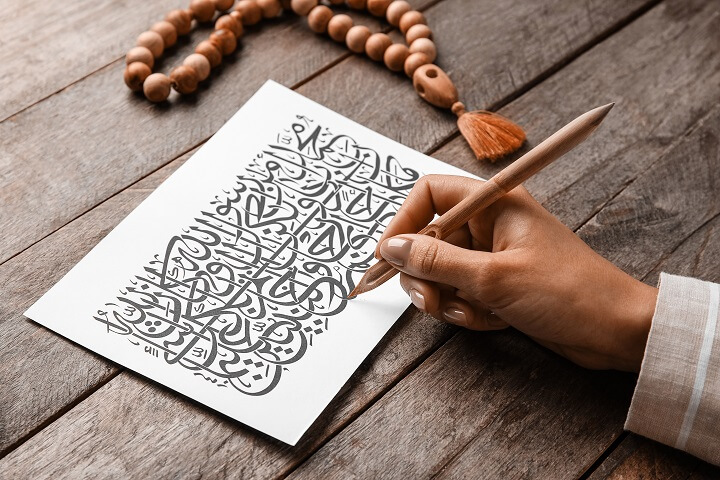Imagine standing at the gateway of the Arabic language; the first thing you’ll see is the first letter: ا /Alif. This letter isn’t just a simple symbol; it’s a key to understanding many of the sounds and rules you’ll encounter on your journey.
To make things easy, let’s get to know the Alif Arabic Letter in all its forms and secrets.
ا /Alif… The First Letter and the Foundation of Sounds
The Arabic letter Alif is the first letter in the Arabic alphabet and is written as a straight line: ا. Its shape is simple, but it plays a very important role.
Alif as a Long Vowel
This is the most common role of the Alif. When it appears without any marks above or below it, it’s used to lengthen the sound of the letter that precedes it.
- Example: The word بَاب (baab). The Alif lengthens the sound of the letter Baa, so it’s pronounced “ba.”
- Example: The word كِتَاب (kitaab). The Alif lengthens the sound of the letter Taa, so it becomes “taa.”
Alif and Hamza: A Very Important Relationship
This is a point where learners often get confused. Always remember that the Hamza (ء) is a sound, while the Alif is often the “chair” that this sound sits on.
Hamza Above Alif
Pronounced with an “a” or “u” sound.
- (ʼarnab – أَرنب) – rabbit
- (ʼuTHnn – أُذن) – ear
Hamza Below Alif
Pronounced with an “i” sound.
- (ʼislaam – إِسلام) – Islam
Hamza on the Line
The Hamza is sometimes written on its own.
- (samaaʼ – سَمَاء) – sky
Alif Madda (آ) and Alif Maqsura (ى): Are They the Same?
Absolutely not! Each has a different shape and use, and understanding them will make you more confident when reading.
Alif Madda (آ)
This Alif is originally a Hamza followed by an Alif. Instead of writing them as “أَا”, they are combined into one letter: آ.
- (ʼaan – آن) – now
- (qurʼan – قُرْآن) – Quran
Alif Maqsura (ى)
Its shape resembles the letter Yaa (ي) but without the dots. Its sound is the same as the long “a” sound of the Alif Madda.
- (mustashfaa – مُسْتَشْفَى) – hospital
- (hatta – حَتَّى) – until
Alif in Grammar: A Glimpse into Rules
Even in grammar, Alif has distinct roles:
- (ʼalif al-Fariqa) ألف التفريق : This is a small, unpronounced Alif that you add at the end of some verbs after the plural “waw,” like in “كتبوا” (kataboo – they wrote). It’s very important for differentiating the plural “waw” from a root “waw” in the word.
- (ʼalif al-Tathniya) ألف التثنية : We add ألف التثنية (ʼalif al-Tathniya), the Dual Alif, to the end of a noun to indicate that there are two of something, such as: “قَلَمَان” (qalamayn – two pens), “كِتَابَان” (kitaaban – two books).
Did you know? Quick Facts About Alif
Here are some interesting details about the Arabic letter Alif that go beyond its basic use.
- Alif in Gematria: In the numerological system “Abjad”, the value of Alif is 1, symbolizing its importance as the first letter.
- Alif in Culture: An Arabic proverb says, “The first of the rain is a drop” (أول الغيث قطرة), where Alif begins the word “awwal” (first), symbolizing a beginning.
Conclusion
After this journey through the world of the Arabic letter Alif, it’s clear that this is more than just the first letter of the alphabet. It is a fundamental building block of the language, with different roles as a long vowel, a carrier for the hamza, and even a key player in grammar. By understanding its various forms—including the Alif Madda (آ) and Alif Maqsura (ى)—you’ve taken a significant step in mastering Arabic. Keep practicing, and you’ll find that this simple, straight line opens up a world of words and meanings. Happy learning!
If you wish to learn more about the Arabic language, download our Arabic learning app.



